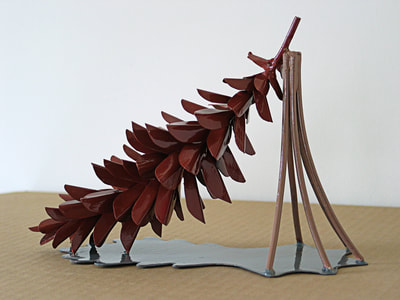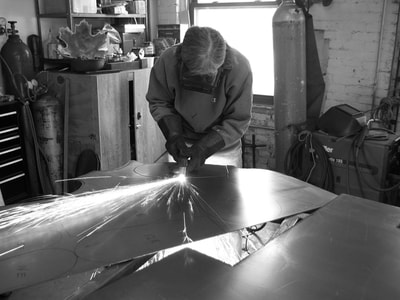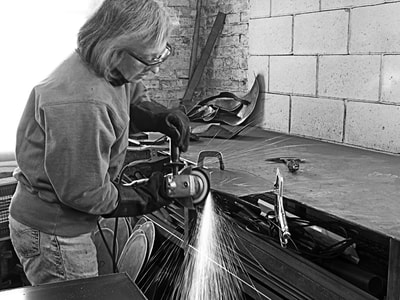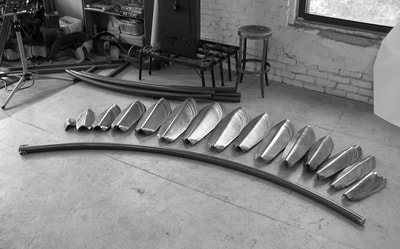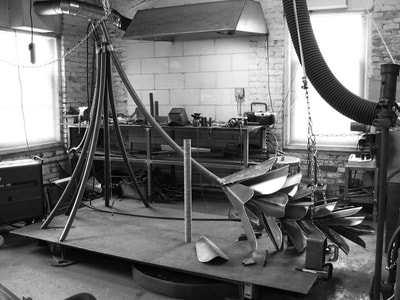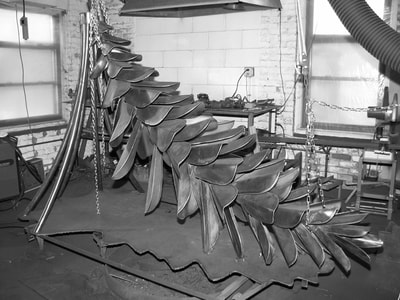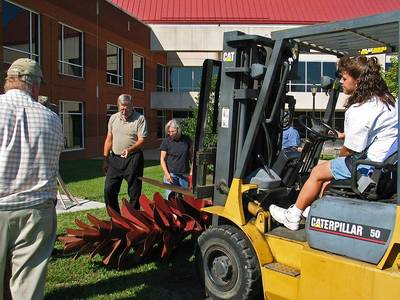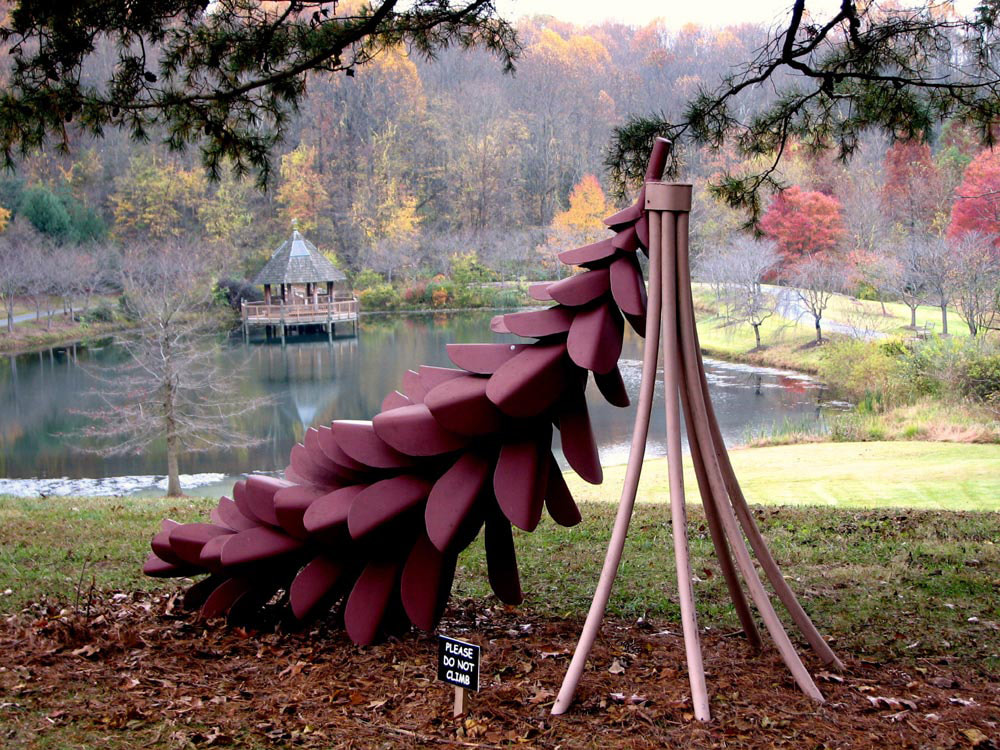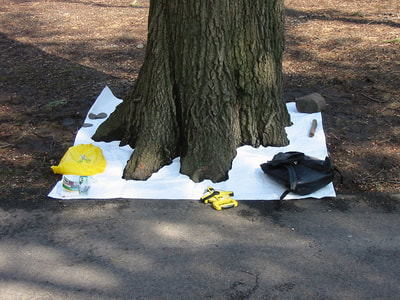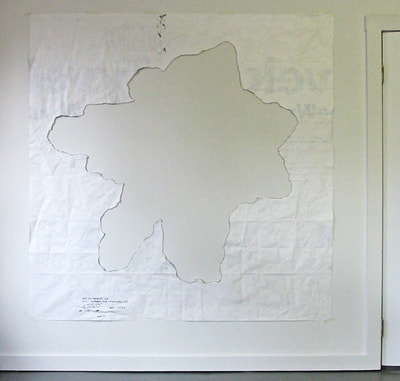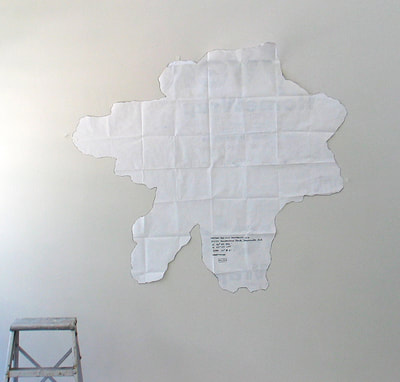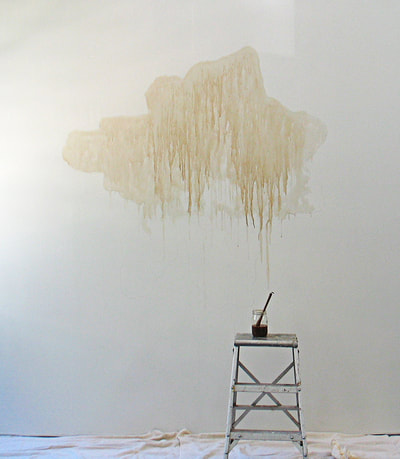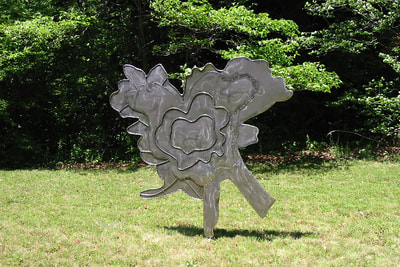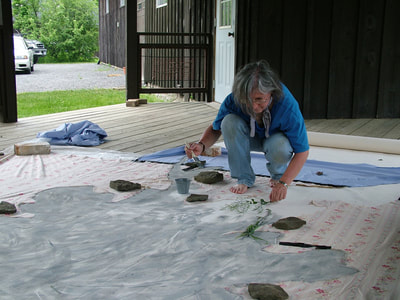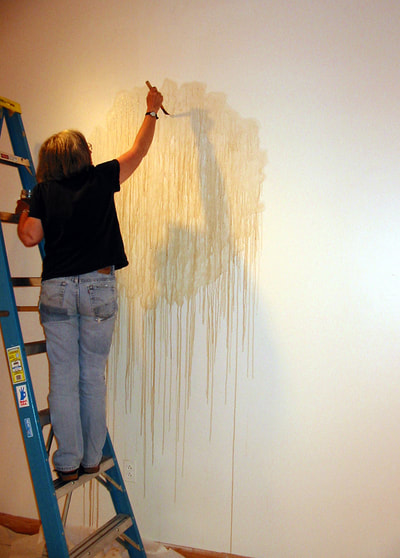steel and fabricated bronze
Someone asked who does my welding for me. Perhaps I seem like an unlikely candidate since I am rather small? The answer is that at least so far I do… with my Millermatic 185 MIG welder. For cutting I use a plasma cutter which runs on compressed air, and I have a chop saw, a small hydraulic table, angle grinders, along with an assortment of other equipment in my studio. One of the first things I built when I secured my first studio was an eight-foot long by thirty-inch wide steel worktable with adjustable legs. Setting up a shop is step one in the process of fabricating.
A few of the stages in making Strobus are shown here. Sculpture often begins with sketches and a maquette, which is a model scaled one inch to a foot. The maquette shown here was made from copper. Since the planned base of the sculpture was wider than the studio door at the time, Strobus was designed to come apart. My new studio has double doors.
Once the design was finalized the shape was scaled up to full size in mild steel. Assembly was tricky with seventy-five scales to place in controlled order. There is a beauty in figuring out each sculpture in that they are all unique.
Strobus was an effort to call attention to an element of nature by making it in a grand scale. Other artists have done this with ordinary human artifacts raising their importance to epic levels. My focus was on aggrandizing simple nature.
A few of the stages in making Strobus are shown here. Sculpture often begins with sketches and a maquette, which is a model scaled one inch to a foot. The maquette shown here was made from copper. Since the planned base of the sculpture was wider than the studio door at the time, Strobus was designed to come apart. My new studio has double doors.
Once the design was finalized the shape was scaled up to full size in mild steel. Assembly was tricky with seventy-five scales to place in controlled order. There is a beauty in figuring out each sculpture in that they are all unique.
Strobus was an effort to call attention to an element of nature by making it in a grand scale. Other artists have done this with ordinary human artifacts raising their importance to epic levels. My focus was on aggrandizing simple nature.
evidences: footprints, driplines
The Evidences take another approach. A shape that is abstract, conceptual, and realistic at once, yet has no impact on its natural subject is the goal. Attention is drawn not only to the natural object, but also to where it is sited, yet without imitating the shape of the actual object.
A tree, rock or other object is chosen based on its physical characteristics, location, and sometimes its meaning. For a footprint, the shape where the tree meets the earth is considered. A sheet of Tyvek (house wrap) is placed at the base of the tree and trimmed where the tree meets the earth. The GPS coordinates and type of tree are recorded and the girth of the tree at four feet above ground is measured and noted along with the date.
At my studio I decide what medium I will use and whether I need a positive of the pattern. Northern Red Oak, MA was to be a wall piece at the Somerville Museum. Since Somerville is a densely populated suburb of Boston there are many commuters. One tree product indicative of their habits is coffee, so I painted it on that surface with coffee. The positive of the footprint pattern was used to plan the placement on the wall, then to trace the shape.
The last image is of Cottonwood Footprint, UT at the Housatonic Museum in Connecticut. I chose coffee again because the environment near that desert cottonwood was a similar sandy color. Other tree products I might use are charcoal, roofing rubber, and repurposed wood.
Maple Footprint en pointe was the first tree footprint I made. It is steel and wind kinetic. The big Silver Maple Footprint, MA was done in Polartec fleece because the factory that originated this fabric is a short drive from the tree and an integral business to the Lawrence community. Sugar Maple Footprint, NY was stenciled onto canvas using the fabric pattern as a template. Originally I used old bed sheets to make the patterns, but switched to Tyvek because it doesn’t tear and is stiffer, therefore more accurate.
A tree, rock or other object is chosen based on its physical characteristics, location, and sometimes its meaning. For a footprint, the shape where the tree meets the earth is considered. A sheet of Tyvek (house wrap) is placed at the base of the tree and trimmed where the tree meets the earth. The GPS coordinates and type of tree are recorded and the girth of the tree at four feet above ground is measured and noted along with the date.
At my studio I decide what medium I will use and whether I need a positive of the pattern. Northern Red Oak, MA was to be a wall piece at the Somerville Museum. Since Somerville is a densely populated suburb of Boston there are many commuters. One tree product indicative of their habits is coffee, so I painted it on that surface with coffee. The positive of the footprint pattern was used to plan the placement on the wall, then to trace the shape.
The last image is of Cottonwood Footprint, UT at the Housatonic Museum in Connecticut. I chose coffee again because the environment near that desert cottonwood was a similar sandy color. Other tree products I might use are charcoal, roofing rubber, and repurposed wood.
Maple Footprint en pointe was the first tree footprint I made. It is steel and wind kinetic. The big Silver Maple Footprint, MA was done in Polartec fleece because the factory that originated this fabric is a short drive from the tree and an integral business to the Lawrence community. Sugar Maple Footprint, NY was stenciled onto canvas using the fabric pattern as a template. Originally I used old bed sheets to make the patterns, but switched to Tyvek because it doesn’t tear and is stiffer, therefore more accurate.


